International Environmental Law: Concerns and Legal Measures on Genetic Modification
VerifiedAdded on 2023/06/15
|12
|3818
|382
AI Summary
This article discusses the concerns and legal measures related to genetic modification under international environmental law. It covers the health and safety, ethical, and trade-related aspects of GM organisms, as well as the Cartagena Protocol on Biosafety and legal measures adopted by India.
Contribute Materials
Your contribution can guide someone’s learning journey. Share your
documents today.
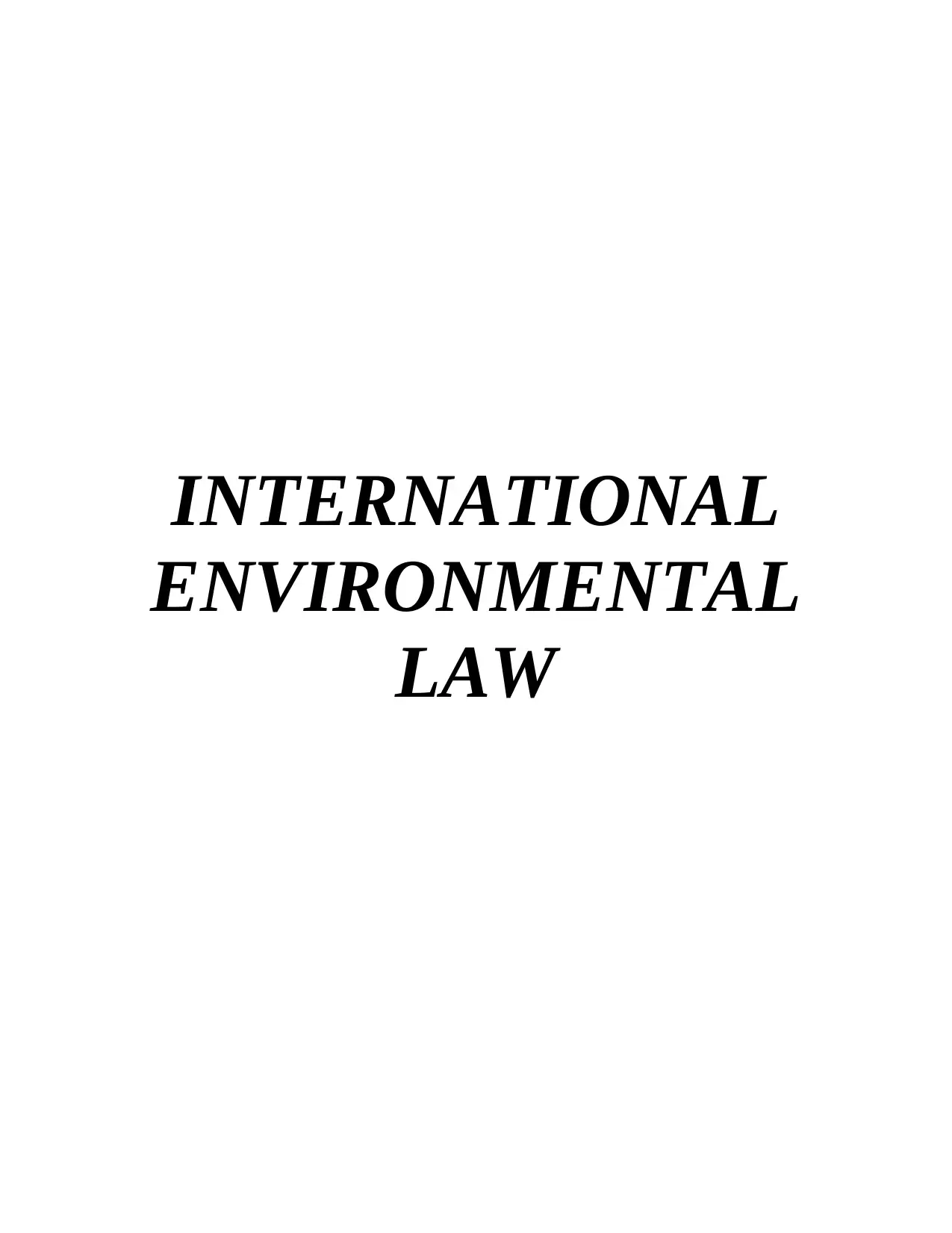
INTERNATIONAL
ENVIRONMENTAL
LAW
ENVIRONMENTAL
LAW
Secure Best Marks with AI Grader
Need help grading? Try our AI Grader for instant feedback on your assignments.
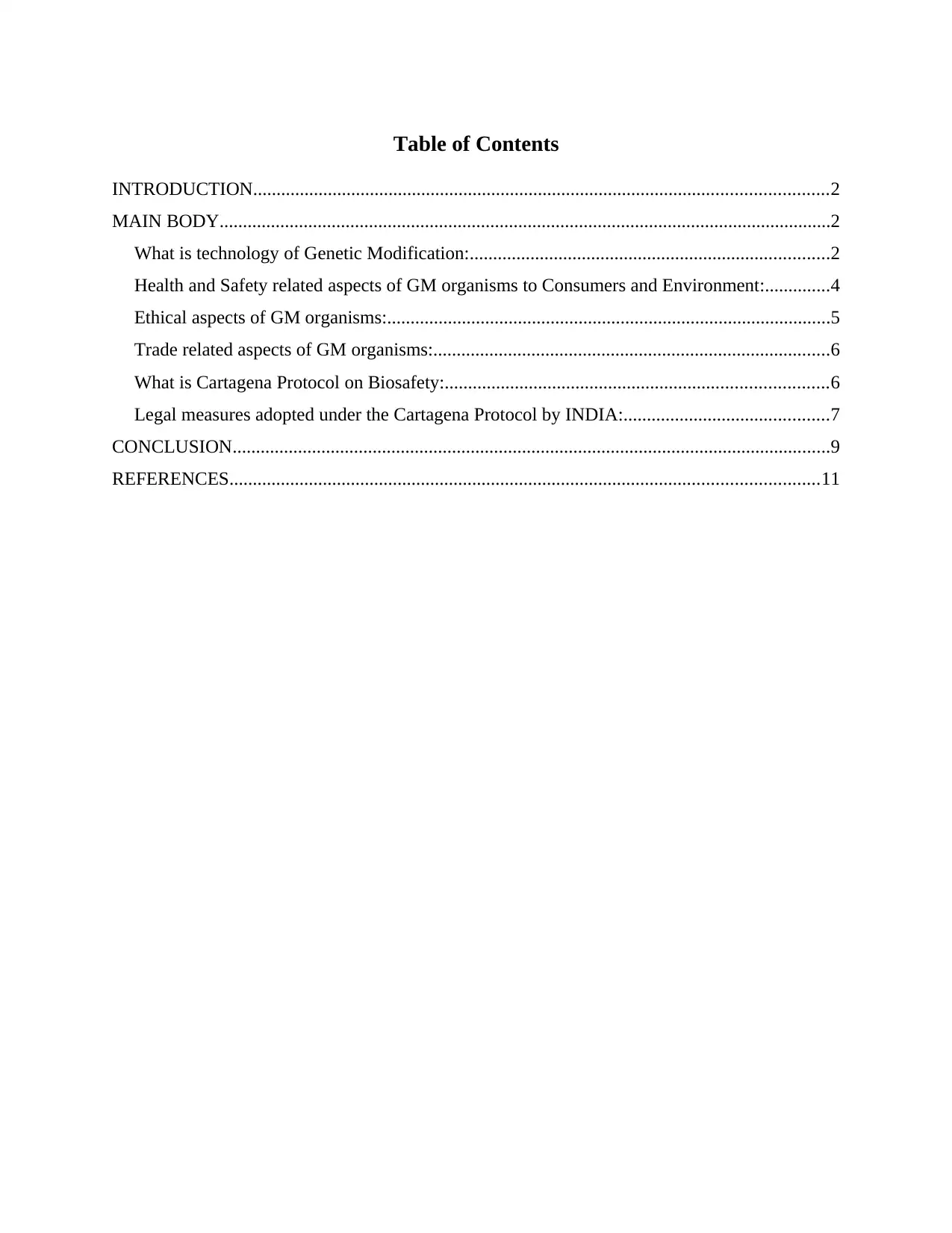
Table of Contents
INTRODUCTION...........................................................................................................................2
MAIN BODY...................................................................................................................................2
What is technology of Genetic Modification:.............................................................................2
Health and Safety related aspects of GM organisms to Consumers and Environment:..............4
Ethical aspects of GM organisms:...............................................................................................5
Trade related aspects of GM organisms:.....................................................................................6
What is Cartagena Protocol on Biosafety:..................................................................................6
Legal measures adopted under the Cartagena Protocol by INDIA:............................................7
CONCLUSION................................................................................................................................9
REFERENCES..............................................................................................................................11
INTRODUCTION...........................................................................................................................2
MAIN BODY...................................................................................................................................2
What is technology of Genetic Modification:.............................................................................2
Health and Safety related aspects of GM organisms to Consumers and Environment:..............4
Ethical aspects of GM organisms:...............................................................................................5
Trade related aspects of GM organisms:.....................................................................................6
What is Cartagena Protocol on Biosafety:..................................................................................6
Legal measures adopted under the Cartagena Protocol by INDIA:............................................7
CONCLUSION................................................................................................................................9
REFERENCES..............................................................................................................................11

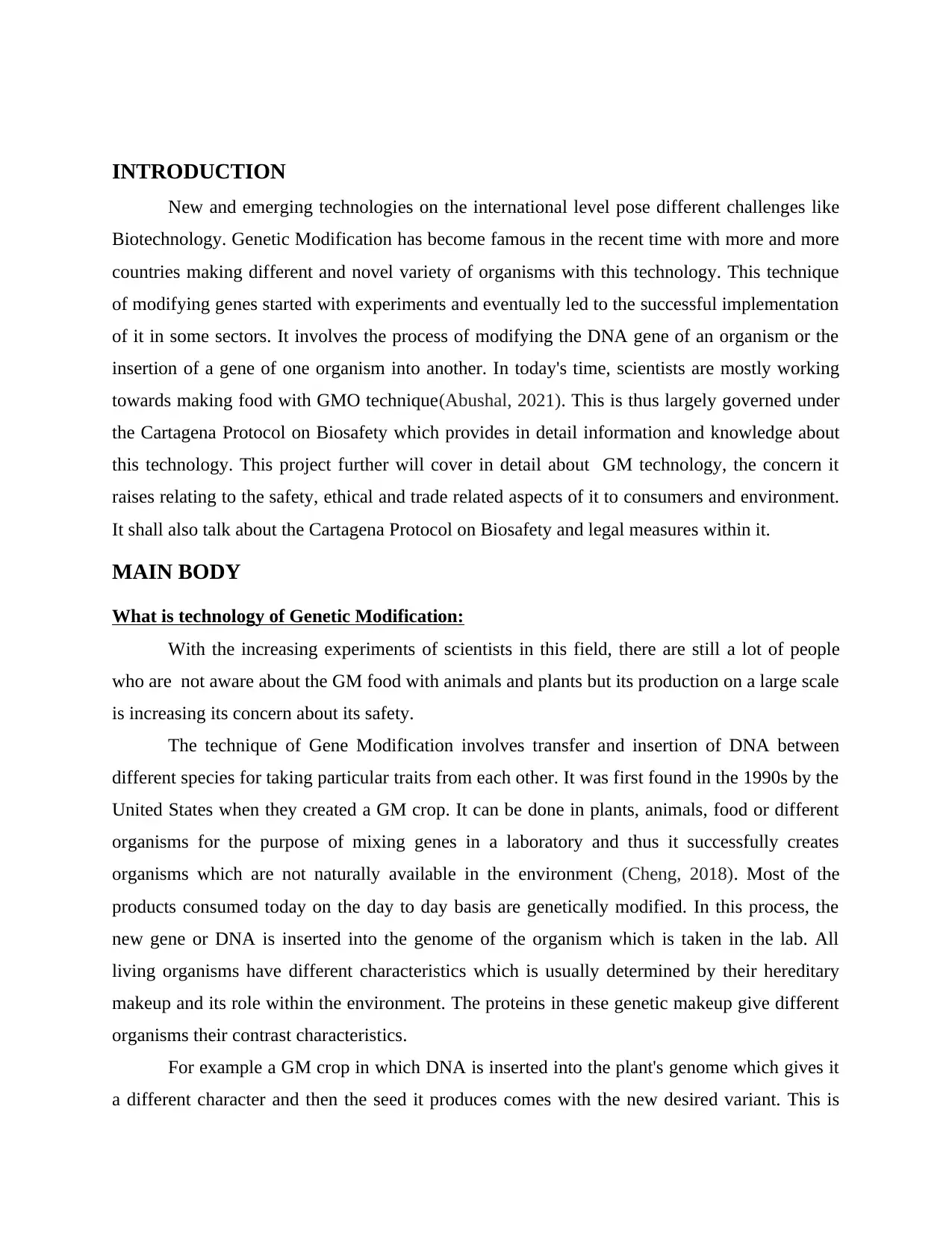
INTRODUCTION
New and emerging technologies on the international level pose different challenges like
Biotechnology. Genetic Modification has become famous in the recent time with more and more
countries making different and novel variety of organisms with this technology. This technique
of modifying genes started with experiments and eventually led to the successful implementation
of it in some sectors. It involves the process of modifying the DNA gene of an organism or the
insertion of a gene of one organism into another. In today's time, scientists are mostly working
towards making food with GMO technique(Abushal, 2021). This is thus largely governed under
the Cartagena Protocol on Biosafety which provides in detail information and knowledge about
this technology. This project further will cover in detail about GM technology, the concern it
raises relating to the safety, ethical and trade related aspects of it to consumers and environment.
It shall also talk about the Cartagena Protocol on Biosafety and legal measures within it.
MAIN BODY
What is technology of Genetic Modification:
With the increasing experiments of scientists in this field, there are still a lot of people
who are not aware about the GM food with animals and plants but its production on a large scale
is increasing its concern about its safety.
The technique of Gene Modification involves transfer and insertion of DNA between
different species for taking particular traits from each other. It was first found in the 1990s by the
United States when they created a GM crop. It can be done in plants, animals, food or different
organisms for the purpose of mixing genes in a laboratory and thus it successfully creates
organisms which are not naturally available in the environment (Cheng, 2018). Most of the
products consumed today on the day to day basis are genetically modified. In this process, the
new gene or DNA is inserted into the genome of the organism which is taken in the lab. All
living organisms have different characteristics which is usually determined by their hereditary
makeup and its role within the environment. The proteins in these genetic makeup give different
organisms their contrast characteristics.
For example a GM crop in which DNA is inserted into the plant's genome which gives it
a different character and then the seed it produces comes with the new desired variant. This is
New and emerging technologies on the international level pose different challenges like
Biotechnology. Genetic Modification has become famous in the recent time with more and more
countries making different and novel variety of organisms with this technology. This technique
of modifying genes started with experiments and eventually led to the successful implementation
of it in some sectors. It involves the process of modifying the DNA gene of an organism or the
insertion of a gene of one organism into another. In today's time, scientists are mostly working
towards making food with GMO technique(Abushal, 2021). This is thus largely governed under
the Cartagena Protocol on Biosafety which provides in detail information and knowledge about
this technology. This project further will cover in detail about GM technology, the concern it
raises relating to the safety, ethical and trade related aspects of it to consumers and environment.
It shall also talk about the Cartagena Protocol on Biosafety and legal measures within it.
MAIN BODY
What is technology of Genetic Modification:
With the increasing experiments of scientists in this field, there are still a lot of people
who are not aware about the GM food with animals and plants but its production on a large scale
is increasing its concern about its safety.
The technique of Gene Modification involves transfer and insertion of DNA between
different species for taking particular traits from each other. It was first found in the 1990s by the
United States when they created a GM crop. It can be done in plants, animals, food or different
organisms for the purpose of mixing genes in a laboratory and thus it successfully creates
organisms which are not naturally available in the environment (Cheng, 2018). Most of the
products consumed today on the day to day basis are genetically modified. In this process, the
new gene or DNA is inserted into the genome of the organism which is taken in the lab. All
living organisms have different characteristics which is usually determined by their hereditary
makeup and its role within the environment. The proteins in these genetic makeup give different
organisms their contrast characteristics.
For example a GM crop in which DNA is inserted into the plant's genome which gives it
a different character and then the seed it produces comes with the new desired variant. This is
Secure Best Marks with AI Grader
Need help grading? Try our AI Grader for instant feedback on your assignments.
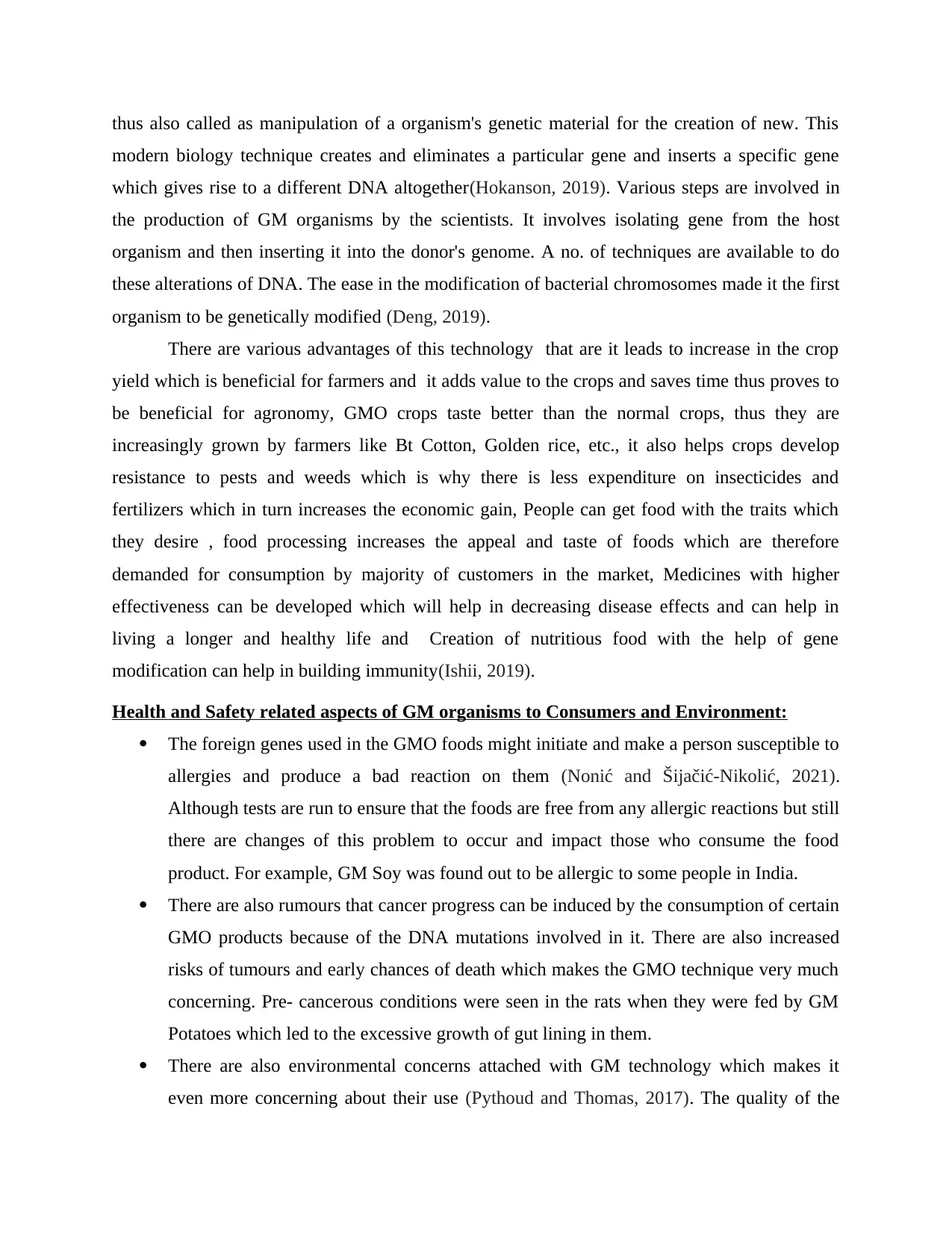
thus also called as manipulation of a organism's genetic material for the creation of new. This
modern biology technique creates and eliminates a particular gene and inserts a specific gene
which gives rise to a different DNA altogether(Hokanson, 2019). Various steps are involved in
the production of GM organisms by the scientists. It involves isolating gene from the host
organism and then inserting it into the donor's genome. A no. of techniques are available to do
these alterations of DNA. The ease in the modification of bacterial chromosomes made it the first
organism to be genetically modified (Deng, 2019).
There are various advantages of this technology that are it leads to increase in the crop
yield which is beneficial for farmers and it adds value to the crops and saves time thus proves to
be beneficial for agronomy, GMO crops taste better than the normal crops, thus they are
increasingly grown by farmers like Bt Cotton, Golden rice, etc., it also helps crops develop
resistance to pests and weeds which is why there is less expenditure on insecticides and
fertilizers which in turn increases the economic gain, People can get food with the traits which
they desire , food processing increases the appeal and taste of foods which are therefore
demanded for consumption by majority of customers in the market, Medicines with higher
effectiveness can be developed which will help in decreasing disease effects and can help in
living a longer and healthy life and Creation of nutritious food with the help of gene
modification can help in building immunity(Ishii, 2019).
Health and Safety related aspects of GM organisms to Consumers and Environment:
The foreign genes used in the GMO foods might initiate and make a person susceptible to
allergies and produce a bad reaction on them (Nonić and Šijačić-Nikolić, 2021).
Although tests are run to ensure that the foods are free from any allergic reactions but still
there are changes of this problem to occur and impact those who consume the food
product. For example, GM Soy was found out to be allergic to some people in India.
There are also rumours that cancer progress can be induced by the consumption of certain
GMO products because of the DNA mutations involved in it. There are also increased
risks of tumours and early chances of death which makes the GMO technique very much
concerning. Pre- cancerous conditions were seen in the rats when they were fed by GM
Potatoes which led to the excessive growth of gut lining in them.
There are also environmental concerns attached with GM technology which makes it
even more concerning about their use (Pythoud and Thomas, 2017). The quality of the
modern biology technique creates and eliminates a particular gene and inserts a specific gene
which gives rise to a different DNA altogether(Hokanson, 2019). Various steps are involved in
the production of GM organisms by the scientists. It involves isolating gene from the host
organism and then inserting it into the donor's genome. A no. of techniques are available to do
these alterations of DNA. The ease in the modification of bacterial chromosomes made it the first
organism to be genetically modified (Deng, 2019).
There are various advantages of this technology that are it leads to increase in the crop
yield which is beneficial for farmers and it adds value to the crops and saves time thus proves to
be beneficial for agronomy, GMO crops taste better than the normal crops, thus they are
increasingly grown by farmers like Bt Cotton, Golden rice, etc., it also helps crops develop
resistance to pests and weeds which is why there is less expenditure on insecticides and
fertilizers which in turn increases the economic gain, People can get food with the traits which
they desire , food processing increases the appeal and taste of foods which are therefore
demanded for consumption by majority of customers in the market, Medicines with higher
effectiveness can be developed which will help in decreasing disease effects and can help in
living a longer and healthy life and Creation of nutritious food with the help of gene
modification can help in building immunity(Ishii, 2019).
Health and Safety related aspects of GM organisms to Consumers and Environment:
The foreign genes used in the GMO foods might initiate and make a person susceptible to
allergies and produce a bad reaction on them (Nonić and Šijačić-Nikolić, 2021).
Although tests are run to ensure that the foods are free from any allergic reactions but still
there are changes of this problem to occur and impact those who consume the food
product. For example, GM Soy was found out to be allergic to some people in India.
There are also rumours that cancer progress can be induced by the consumption of certain
GMO products because of the DNA mutations involved in it. There are also increased
risks of tumours and early chances of death which makes the GMO technique very much
concerning. Pre- cancerous conditions were seen in the rats when they were fed by GM
Potatoes which led to the excessive growth of gut lining in them.
There are also environmental concerns attached with GM technology which makes it
even more concerning about their use (Pythoud and Thomas, 2017). The quality of the
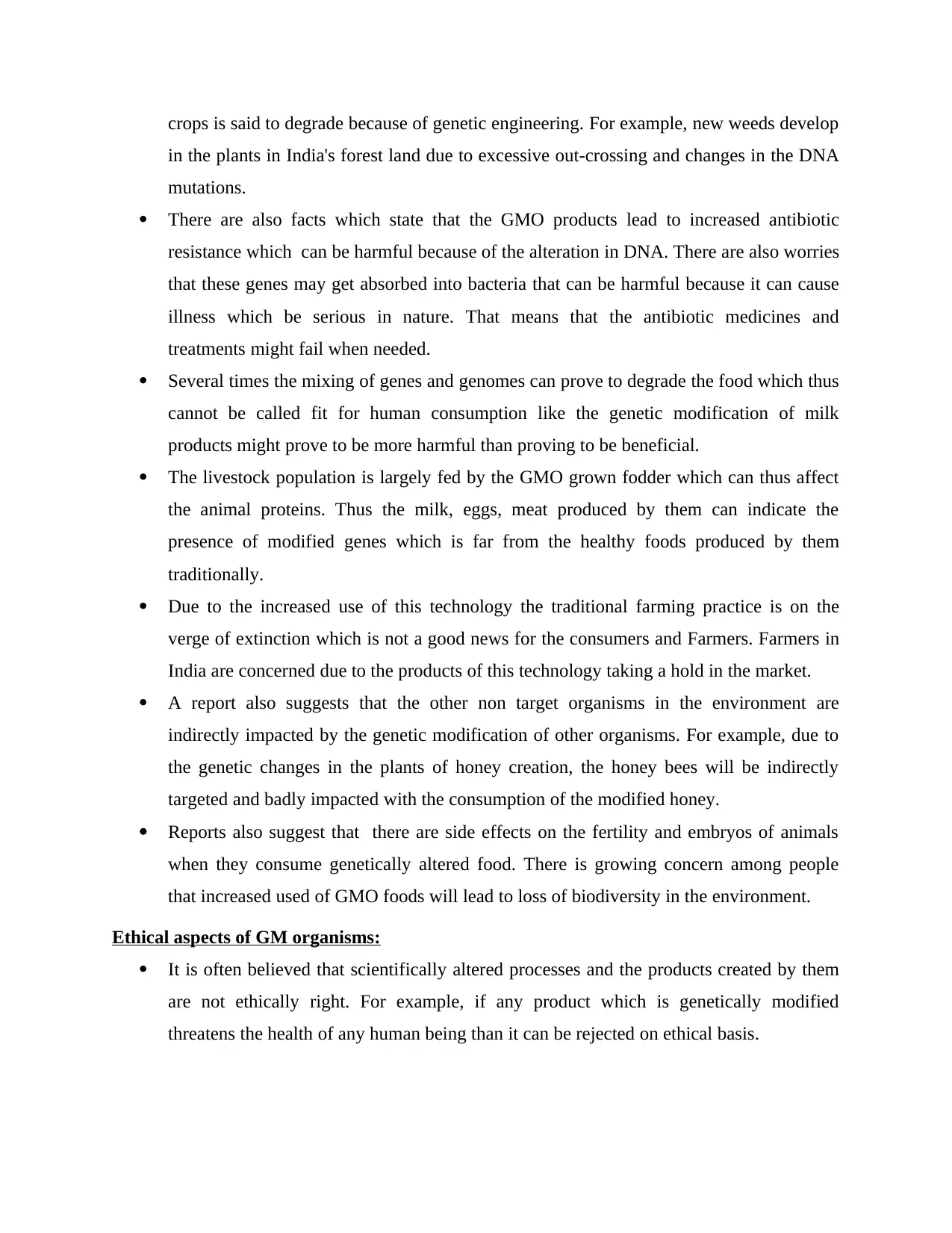
crops is said to degrade because of genetic engineering. For example, new weeds develop
in the plants in India's forest land due to excessive out-crossing and changes in the DNA
mutations.
There are also facts which state that the GMO products lead to increased antibiotic
resistance which can be harmful because of the alteration in DNA. There are also worries
that these genes may get absorbed into bacteria that can be harmful because it can cause
illness which be serious in nature. That means that the antibiotic medicines and
treatments might fail when needed.
Several times the mixing of genes and genomes can prove to degrade the food which thus
cannot be called fit for human consumption like the genetic modification of milk
products might prove to be more harmful than proving to be beneficial.
The livestock population is largely fed by the GMO grown fodder which can thus affect
the animal proteins. Thus the milk, eggs, meat produced by them can indicate the
presence of modified genes which is far from the healthy foods produced by them
traditionally.
Due to the increased use of this technology the traditional farming practice is on the
verge of extinction which is not a good news for the consumers and Farmers. Farmers in
India are concerned due to the products of this technology taking a hold in the market.
A report also suggests that the other non target organisms in the environment are
indirectly impacted by the genetic modification of other organisms. For example, due to
the genetic changes in the plants of honey creation, the honey bees will be indirectly
targeted and badly impacted with the consumption of the modified honey.
Reports also suggest that there are side effects on the fertility and embryos of animals
when they consume genetically altered food. There is growing concern among people
that increased used of GMO foods will lead to loss of biodiversity in the environment.
Ethical aspects of GM organisms:
It is often believed that scientifically altered processes and the products created by them
are not ethically right. For example, if any product which is genetically modified
threatens the health of any human being than it can be rejected on ethical basis.
in the plants in India's forest land due to excessive out-crossing and changes in the DNA
mutations.
There are also facts which state that the GMO products lead to increased antibiotic
resistance which can be harmful because of the alteration in DNA. There are also worries
that these genes may get absorbed into bacteria that can be harmful because it can cause
illness which be serious in nature. That means that the antibiotic medicines and
treatments might fail when needed.
Several times the mixing of genes and genomes can prove to degrade the food which thus
cannot be called fit for human consumption like the genetic modification of milk
products might prove to be more harmful than proving to be beneficial.
The livestock population is largely fed by the GMO grown fodder which can thus affect
the animal proteins. Thus the milk, eggs, meat produced by them can indicate the
presence of modified genes which is far from the healthy foods produced by them
traditionally.
Due to the increased use of this technology the traditional farming practice is on the
verge of extinction which is not a good news for the consumers and Farmers. Farmers in
India are concerned due to the products of this technology taking a hold in the market.
A report also suggests that the other non target organisms in the environment are
indirectly impacted by the genetic modification of other organisms. For example, due to
the genetic changes in the plants of honey creation, the honey bees will be indirectly
targeted and badly impacted with the consumption of the modified honey.
Reports also suggest that there are side effects on the fertility and embryos of animals
when they consume genetically altered food. There is growing concern among people
that increased used of GMO foods will lead to loss of biodiversity in the environment.
Ethical aspects of GM organisms:
It is often believed that scientifically altered processes and the products created by them
are not ethically right. For example, if any product which is genetically modified
threatens the health of any human being than it can be rejected on ethical basis.
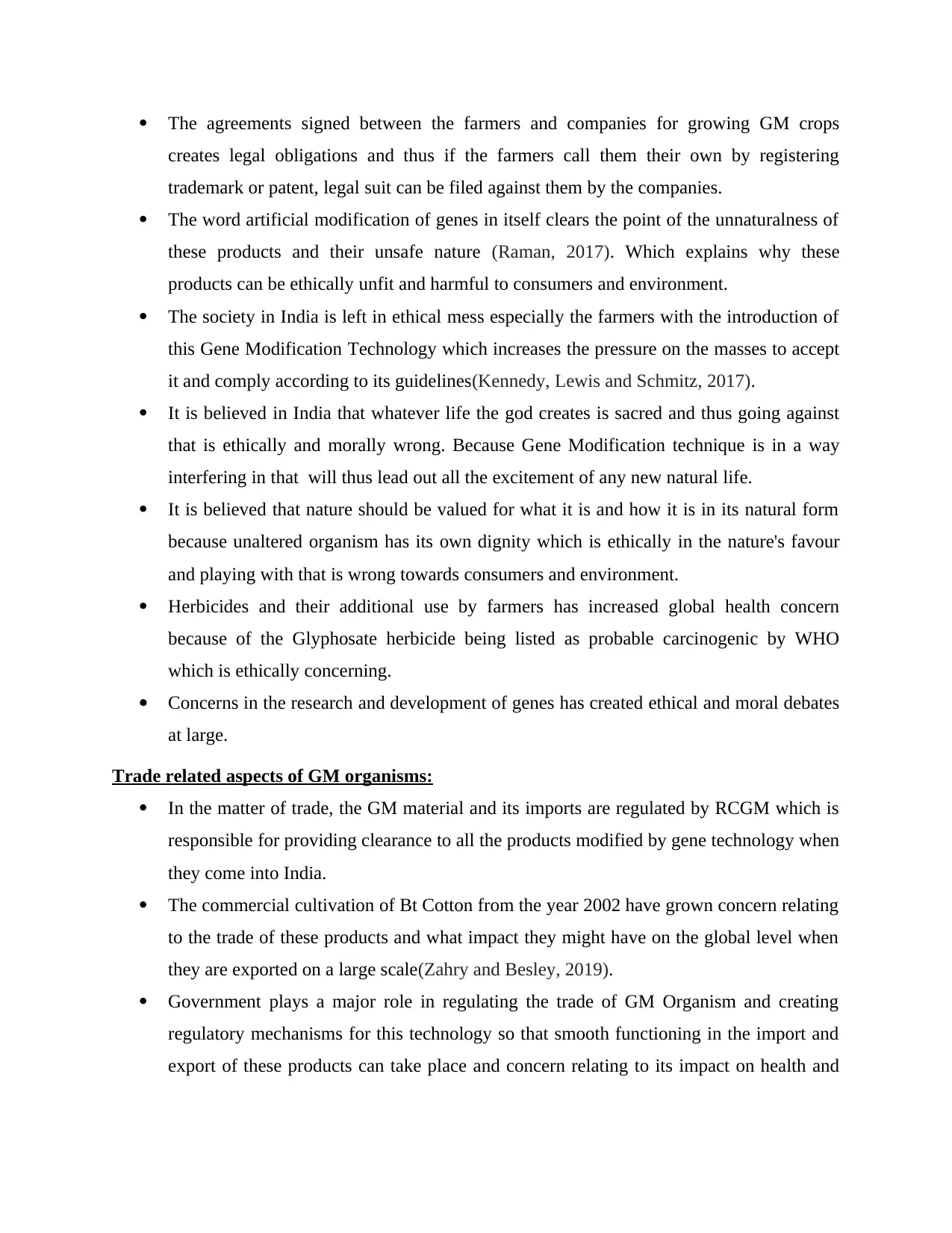
The agreements signed between the farmers and companies for growing GM crops
creates legal obligations and thus if the farmers call them their own by registering
trademark or patent, legal suit can be filed against them by the companies.
The word artificial modification of genes in itself clears the point of the unnaturalness of
these products and their unsafe nature (Raman, 2017). Which explains why these
products can be ethically unfit and harmful to consumers and environment.
The society in India is left in ethical mess especially the farmers with the introduction of
this Gene Modification Technology which increases the pressure on the masses to accept
it and comply according to its guidelines(Kennedy, Lewis and Schmitz, 2017).
It is believed in India that whatever life the god creates is sacred and thus going against
that is ethically and morally wrong. Because Gene Modification technique is in a way
interfering in that will thus lead out all the excitement of any new natural life.
It is believed that nature should be valued for what it is and how it is in its natural form
because unaltered organism has its own dignity which is ethically in the nature's favour
and playing with that is wrong towards consumers and environment.
Herbicides and their additional use by farmers has increased global health concern
because of the Glyphosate herbicide being listed as probable carcinogenic by WHO
which is ethically concerning.
Concerns in the research and development of genes has created ethical and moral debates
at large.
Trade related aspects of GM organisms:
In the matter of trade, the GM material and its imports are regulated by RCGM which is
responsible for providing clearance to all the products modified by gene technology when
they come into India.
The commercial cultivation of Bt Cotton from the year 2002 have grown concern relating
to the trade of these products and what impact they might have on the global level when
they are exported on a large scale(Zahry and Besley, 2019).
Government plays a major role in regulating the trade of GM Organism and creating
regulatory mechanisms for this technology so that smooth functioning in the import and
export of these products can take place and concern relating to its impact on health and
creates legal obligations and thus if the farmers call them their own by registering
trademark or patent, legal suit can be filed against them by the companies.
The word artificial modification of genes in itself clears the point of the unnaturalness of
these products and their unsafe nature (Raman, 2017). Which explains why these
products can be ethically unfit and harmful to consumers and environment.
The society in India is left in ethical mess especially the farmers with the introduction of
this Gene Modification Technology which increases the pressure on the masses to accept
it and comply according to its guidelines(Kennedy, Lewis and Schmitz, 2017).
It is believed in India that whatever life the god creates is sacred and thus going against
that is ethically and morally wrong. Because Gene Modification technique is in a way
interfering in that will thus lead out all the excitement of any new natural life.
It is believed that nature should be valued for what it is and how it is in its natural form
because unaltered organism has its own dignity which is ethically in the nature's favour
and playing with that is wrong towards consumers and environment.
Herbicides and their additional use by farmers has increased global health concern
because of the Glyphosate herbicide being listed as probable carcinogenic by WHO
which is ethically concerning.
Concerns in the research and development of genes has created ethical and moral debates
at large.
Trade related aspects of GM organisms:
In the matter of trade, the GM material and its imports are regulated by RCGM which is
responsible for providing clearance to all the products modified by gene technology when
they come into India.
The commercial cultivation of Bt Cotton from the year 2002 have grown concern relating
to the trade of these products and what impact they might have on the global level when
they are exported on a large scale(Zahry and Besley, 2019).
Government plays a major role in regulating the trade of GM Organism and creating
regulatory mechanisms for this technology so that smooth functioning in the import and
export of these products can take place and concern relating to its impact on health and
Paraphrase This Document
Need a fresh take? Get an instant paraphrase of this document with our AI Paraphraser
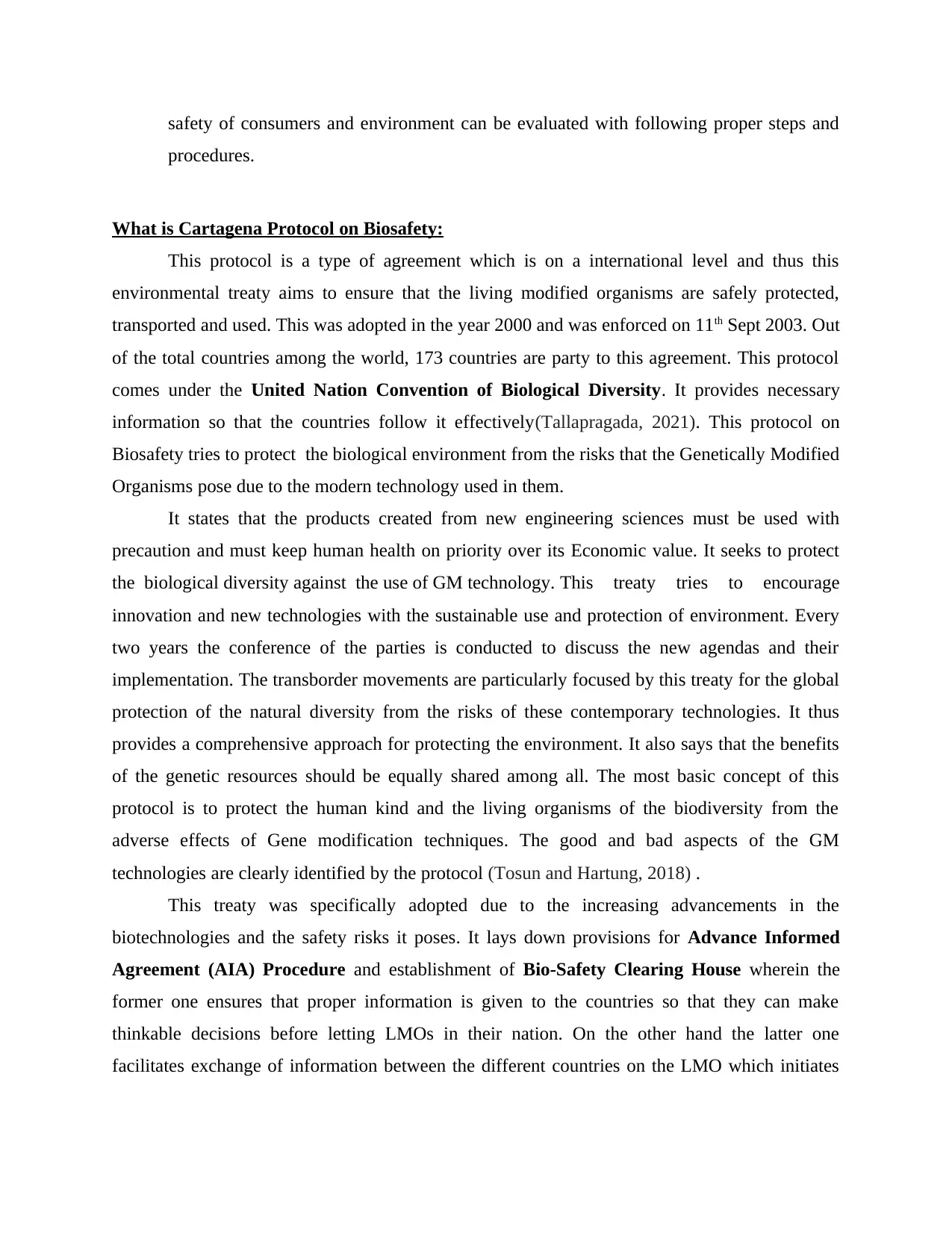
safety of consumers and environment can be evaluated with following proper steps and
procedures.
What is Cartagena Protocol on Biosafety:
This protocol is a type of agreement which is on a international level and thus this
environmental treaty aims to ensure that the living modified organisms are safely protected,
transported and used. This was adopted in the year 2000 and was enforced on 11th Sept 2003. Out
of the total countries among the world, 173 countries are party to this agreement. This protocol
comes under the United Nation Convention of Biological Diversity. It provides necessary
information so that the countries follow it effectively(Tallapragada, 2021). This protocol on
Biosafety tries to protect the biological environment from the risks that the Genetically Modified
Organisms pose due to the modern technology used in them.
It states that the products created from new engineering sciences must be used with
precaution and must keep human health on priority over its Economic value. It seeks to protect
the biological diversity against the use of GM technology. This treaty tries to encourage
innovation and new technologies with the sustainable use and protection of environment. Every
two years the conference of the parties is conducted to discuss the new agendas and their
implementation. The transborder movements are particularly focused by this treaty for the global
protection of the natural diversity from the risks of these contemporary technologies. It thus
provides a comprehensive approach for protecting the environment. It also says that the benefits
of the genetic resources should be equally shared among all. The most basic concept of this
protocol is to protect the human kind and the living organisms of the biodiversity from the
adverse effects of Gene modification techniques. The good and bad aspects of the GM
technologies are clearly identified by the protocol (Tosun and Hartung, 2018) .
This treaty was specifically adopted due to the increasing advancements in the
biotechnologies and the safety risks it poses. It lays down provisions for Advance Informed
Agreement (AIA) Procedure and establishment of Bio-Safety Clearing House wherein the
former one ensures that proper information is given to the countries so that they can make
thinkable decisions before letting LMOs in their nation. On the other hand the latter one
facilitates exchange of information between the different countries on the LMO which initiates
procedures.
What is Cartagena Protocol on Biosafety:
This protocol is a type of agreement which is on a international level and thus this
environmental treaty aims to ensure that the living modified organisms are safely protected,
transported and used. This was adopted in the year 2000 and was enforced on 11th Sept 2003. Out
of the total countries among the world, 173 countries are party to this agreement. This protocol
comes under the United Nation Convention of Biological Diversity. It provides necessary
information so that the countries follow it effectively(Tallapragada, 2021). This protocol on
Biosafety tries to protect the biological environment from the risks that the Genetically Modified
Organisms pose due to the modern technology used in them.
It states that the products created from new engineering sciences must be used with
precaution and must keep human health on priority over its Economic value. It seeks to protect
the biological diversity against the use of GM technology. This treaty tries to encourage
innovation and new technologies with the sustainable use and protection of environment. Every
two years the conference of the parties is conducted to discuss the new agendas and their
implementation. The transborder movements are particularly focused by this treaty for the global
protection of the natural diversity from the risks of these contemporary technologies. It thus
provides a comprehensive approach for protecting the environment. It also says that the benefits
of the genetic resources should be equally shared among all. The most basic concept of this
protocol is to protect the human kind and the living organisms of the biodiversity from the
adverse effects of Gene modification techniques. The good and bad aspects of the GM
technologies are clearly identified by the protocol (Tosun and Hartung, 2018) .
This treaty was specifically adopted due to the increasing advancements in the
biotechnologies and the safety risks it poses. It lays down provisions for Advance Informed
Agreement (AIA) Procedure and establishment of Bio-Safety Clearing House wherein the
former one ensures that proper information is given to the countries so that they can make
thinkable decisions before letting LMOs in their nation. On the other hand the latter one
facilitates exchange of information between the different countries on the LMO which initiates
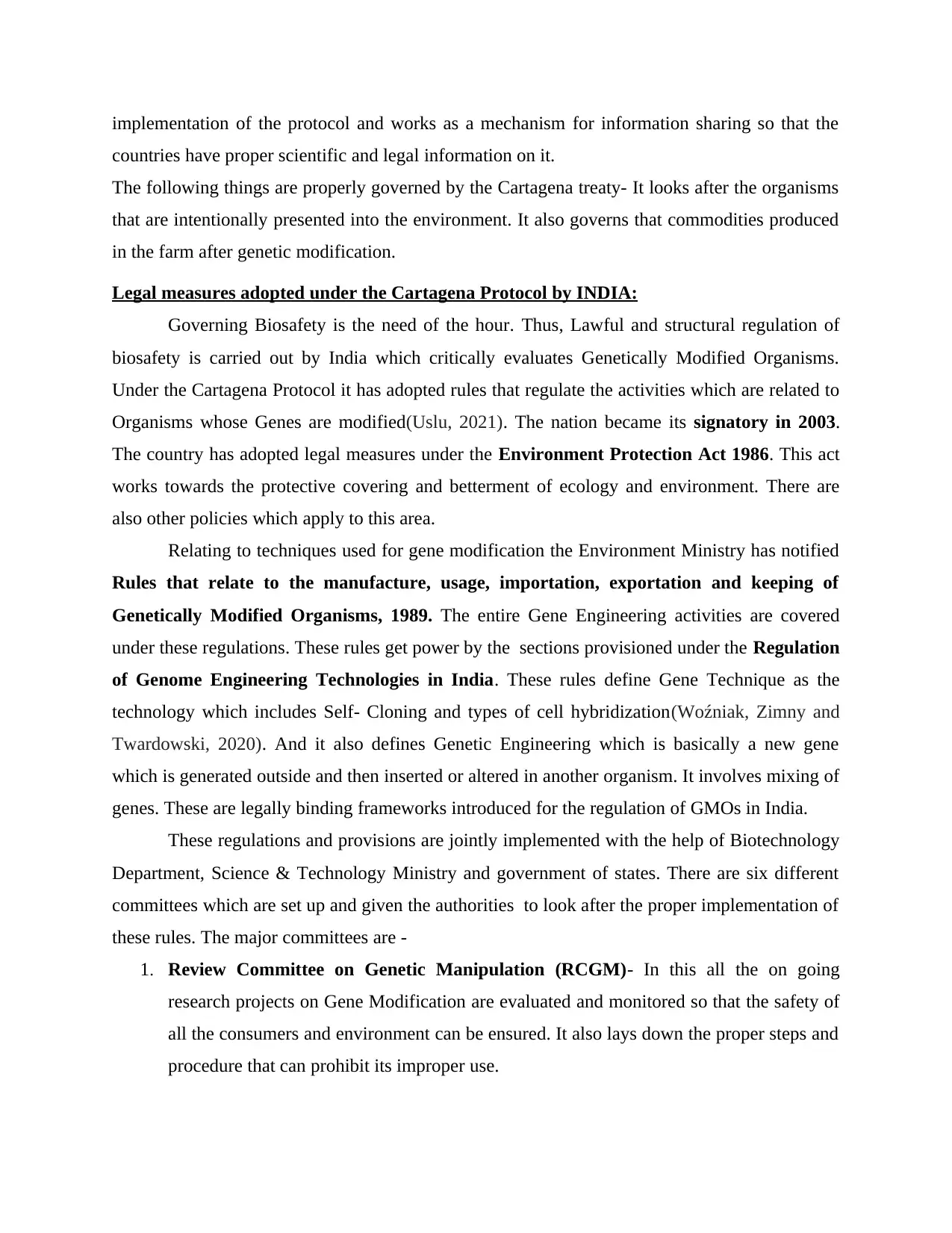
implementation of the protocol and works as a mechanism for information sharing so that the
countries have proper scientific and legal information on it.
The following things are properly governed by the Cartagena treaty- It looks after the organisms
that are intentionally presented into the environment. It also governs that commodities produced
in the farm after genetic modification.
Legal measures adopted under the Cartagena Protocol by INDIA:
Governing Biosafety is the need of the hour. Thus, Lawful and structural regulation of
biosafety is carried out by India which critically evaluates Genetically Modified Organisms.
Under the Cartagena Protocol it has adopted rules that regulate the activities which are related to
Organisms whose Genes are modified(Uslu, 2021). The nation became its signatory in 2003.
The country has adopted legal measures under the Environment Protection Act 1986. This act
works towards the protective covering and betterment of ecology and environment. There are
also other policies which apply to this area.
Relating to techniques used for gene modification the Environment Ministry has notified
Rules that relate to the manufacture, usage, importation, exportation and keeping of
Genetically Modified Organisms, 1989. The entire Gene Engineering activities are covered
under these regulations. These rules get power by the sections provisioned under the Regulation
of Genome Engineering Technologies in India. These rules define Gene Technique as the
technology which includes Self- Cloning and types of cell hybridization(Woźniak, Zimny and
Twardowski, 2020). And it also defines Genetic Engineering which is basically a new gene
which is generated outside and then inserted or altered in another organism. It involves mixing of
genes. These are legally binding frameworks introduced for the regulation of GMOs in India.
These regulations and provisions are jointly implemented with the help of Biotechnology
Department, Science & Technology Ministry and government of states. There are six different
committees which are set up and given the authorities to look after the proper implementation of
these rules. The major committees are -
1. Review Committee on Genetic Manipulation (RCGM)- In this all the on going
research projects on Gene Modification are evaluated and monitored so that the safety of
all the consumers and environment can be ensured. It also lays down the proper steps and
procedure that can prohibit its improper use.
countries have proper scientific and legal information on it.
The following things are properly governed by the Cartagena treaty- It looks after the organisms
that are intentionally presented into the environment. It also governs that commodities produced
in the farm after genetic modification.
Legal measures adopted under the Cartagena Protocol by INDIA:
Governing Biosafety is the need of the hour. Thus, Lawful and structural regulation of
biosafety is carried out by India which critically evaluates Genetically Modified Organisms.
Under the Cartagena Protocol it has adopted rules that regulate the activities which are related to
Organisms whose Genes are modified(Uslu, 2021). The nation became its signatory in 2003.
The country has adopted legal measures under the Environment Protection Act 1986. This act
works towards the protective covering and betterment of ecology and environment. There are
also other policies which apply to this area.
Relating to techniques used for gene modification the Environment Ministry has notified
Rules that relate to the manufacture, usage, importation, exportation and keeping of
Genetically Modified Organisms, 1989. The entire Gene Engineering activities are covered
under these regulations. These rules get power by the sections provisioned under the Regulation
of Genome Engineering Technologies in India. These rules define Gene Technique as the
technology which includes Self- Cloning and types of cell hybridization(Woźniak, Zimny and
Twardowski, 2020). And it also defines Genetic Engineering which is basically a new gene
which is generated outside and then inserted or altered in another organism. It involves mixing of
genes. These are legally binding frameworks introduced for the regulation of GMOs in India.
These regulations and provisions are jointly implemented with the help of Biotechnology
Department, Science & Technology Ministry and government of states. There are six different
committees which are set up and given the authorities to look after the proper implementation of
these rules. The major committees are -
1. Review Committee on Genetic Manipulation (RCGM)- In this all the on going
research projects on Gene Modification are evaluated and monitored so that the safety of
all the consumers and environment can be ensured. It also lays down the proper steps and
procedure that can prohibit its improper use.
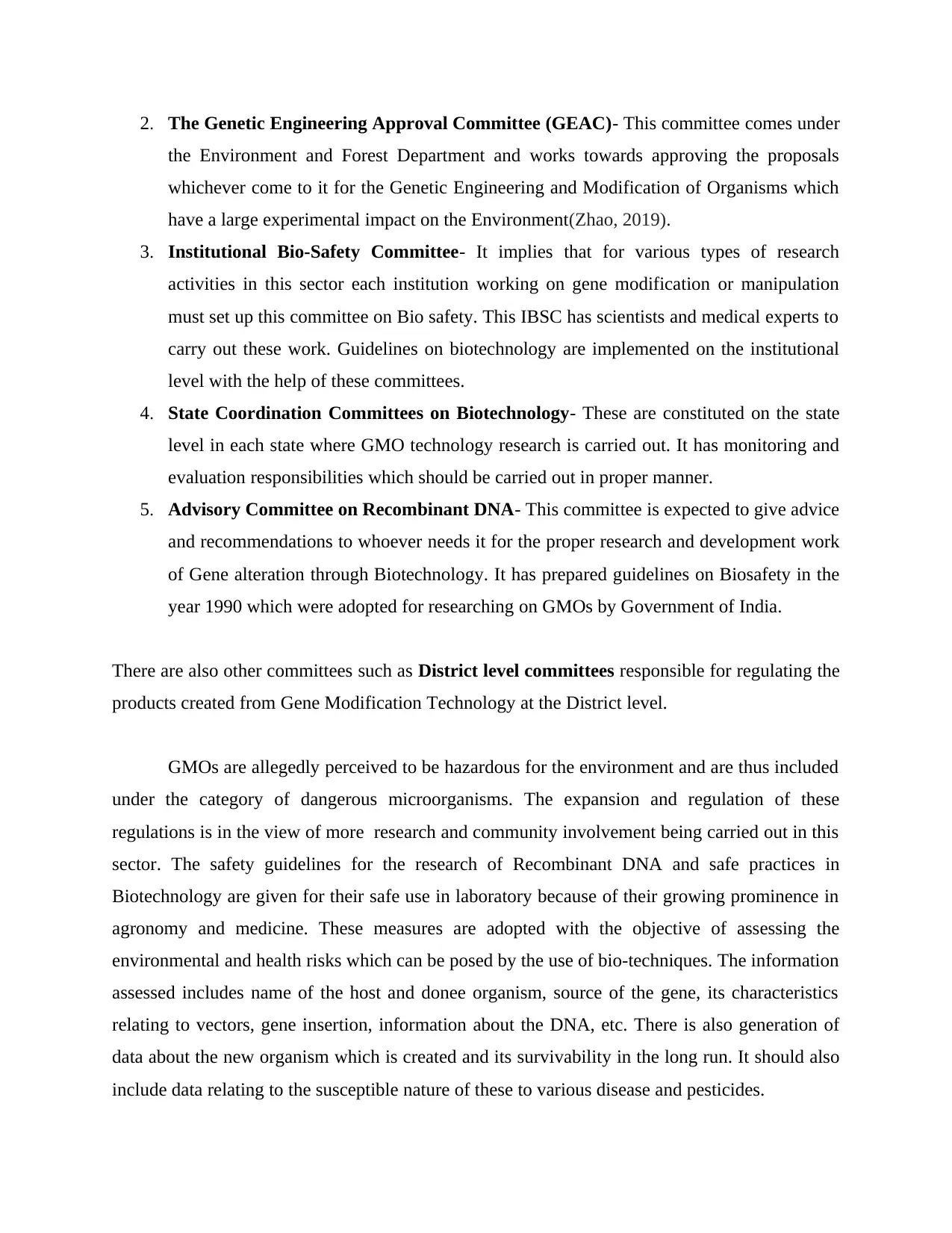
2. The Genetic Engineering Approval Committee (GEAC)- This committee comes under
the Environment and Forest Department and works towards approving the proposals
whichever come to it for the Genetic Engineering and Modification of Organisms which
have a large experimental impact on the Environment(Zhao, 2019).
3. Institutional Bio-Safety Committee- It implies that for various types of research
activities in this sector each institution working on gene modification or manipulation
must set up this committee on Bio safety. This IBSC has scientists and medical experts to
carry out these work. Guidelines on biotechnology are implemented on the institutional
level with the help of these committees.
4. State Coordination Committees on Biotechnology- These are constituted on the state
level in each state where GMO technology research is carried out. It has monitoring and
evaluation responsibilities which should be carried out in proper manner.
5. Advisory Committee on Recombinant DNA- This committee is expected to give advice
and recommendations to whoever needs it for the proper research and development work
of Gene alteration through Biotechnology. It has prepared guidelines on Biosafety in the
year 1990 which were adopted for researching on GMOs by Government of India.
There are also other committees such as District level committees responsible for regulating the
products created from Gene Modification Technology at the District level.
GMOs are allegedly perceived to be hazardous for the environment and are thus included
under the category of dangerous microorganisms. The expansion and regulation of these
regulations is in the view of more research and community involvement being carried out in this
sector. The safety guidelines for the research of Recombinant DNA and safe practices in
Biotechnology are given for their safe use in laboratory because of their growing prominence in
agronomy and medicine. These measures are adopted with the objective of assessing the
environmental and health risks which can be posed by the use of bio-techniques. The information
assessed includes name of the host and donee organism, source of the gene, its characteristics
relating to vectors, gene insertion, information about the DNA, etc. There is also generation of
data about the new organism which is created and its survivability in the long run. It should also
include data relating to the susceptible nature of these to various disease and pesticides.
the Environment and Forest Department and works towards approving the proposals
whichever come to it for the Genetic Engineering and Modification of Organisms which
have a large experimental impact on the Environment(Zhao, 2019).
3. Institutional Bio-Safety Committee- It implies that for various types of research
activities in this sector each institution working on gene modification or manipulation
must set up this committee on Bio safety. This IBSC has scientists and medical experts to
carry out these work. Guidelines on biotechnology are implemented on the institutional
level with the help of these committees.
4. State Coordination Committees on Biotechnology- These are constituted on the state
level in each state where GMO technology research is carried out. It has monitoring and
evaluation responsibilities which should be carried out in proper manner.
5. Advisory Committee on Recombinant DNA- This committee is expected to give advice
and recommendations to whoever needs it for the proper research and development work
of Gene alteration through Biotechnology. It has prepared guidelines on Biosafety in the
year 1990 which were adopted for researching on GMOs by Government of India.
There are also other committees such as District level committees responsible for regulating the
products created from Gene Modification Technology at the District level.
GMOs are allegedly perceived to be hazardous for the environment and are thus included
under the category of dangerous microorganisms. The expansion and regulation of these
regulations is in the view of more research and community involvement being carried out in this
sector. The safety guidelines for the research of Recombinant DNA and safe practices in
Biotechnology are given for their safe use in laboratory because of their growing prominence in
agronomy and medicine. These measures are adopted with the objective of assessing the
environmental and health risks which can be posed by the use of bio-techniques. The information
assessed includes name of the host and donee organism, source of the gene, its characteristics
relating to vectors, gene insertion, information about the DNA, etc. There is also generation of
data about the new organism which is created and its survivability in the long run. It should also
include data relating to the susceptible nature of these to various disease and pesticides.
Secure Best Marks with AI Grader
Need help grading? Try our AI Grader for instant feedback on your assignments.
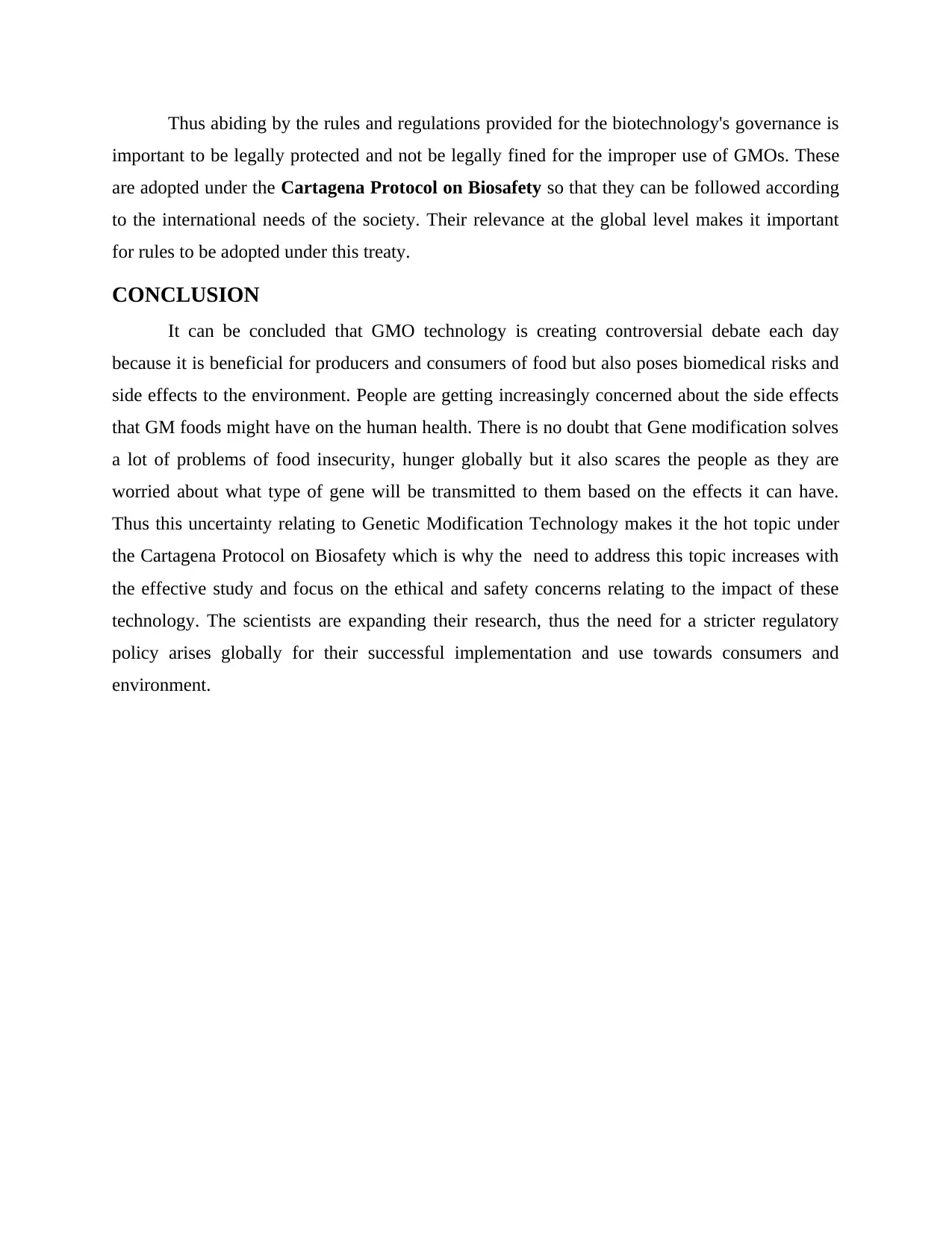
Thus abiding by the rules and regulations provided for the biotechnology's governance is
important to be legally protected and not be legally fined for the improper use of GMOs. These
are adopted under the Cartagena Protocol on Biosafety so that they can be followed according
to the international needs of the society. Their relevance at the global level makes it important
for rules to be adopted under this treaty.
CONCLUSION
It can be concluded that GMO technology is creating controversial debate each day
because it is beneficial for producers and consumers of food but also poses biomedical risks and
side effects to the environment. People are getting increasingly concerned about the side effects
that GM foods might have on the human health. There is no doubt that Gene modification solves
a lot of problems of food insecurity, hunger globally but it also scares the people as they are
worried about what type of gene will be transmitted to them based on the effects it can have.
Thus this uncertainty relating to Genetic Modification Technology makes it the hot topic under
the Cartagena Protocol on Biosafety which is why the need to address this topic increases with
the effective study and focus on the ethical and safety concerns relating to the impact of these
technology. The scientists are expanding their research, thus the need for a stricter regulatory
policy arises globally for their successful implementation and use towards consumers and
environment.
important to be legally protected and not be legally fined for the improper use of GMOs. These
are adopted under the Cartagena Protocol on Biosafety so that they can be followed according
to the international needs of the society. Their relevance at the global level makes it important
for rules to be adopted under this treaty.
CONCLUSION
It can be concluded that GMO technology is creating controversial debate each day
because it is beneficial for producers and consumers of food but also poses biomedical risks and
side effects to the environment. People are getting increasingly concerned about the side effects
that GM foods might have on the human health. There is no doubt that Gene modification solves
a lot of problems of food insecurity, hunger globally but it also scares the people as they are
worried about what type of gene will be transmitted to them based on the effects it can have.
Thus this uncertainty relating to Genetic Modification Technology makes it the hot topic under
the Cartagena Protocol on Biosafety which is why the need to address this topic increases with
the effective study and focus on the ethical and safety concerns relating to the impact of these
technology. The scientists are expanding their research, thus the need for a stricter regulatory
policy arises globally for their successful implementation and use towards consumers and
environment.
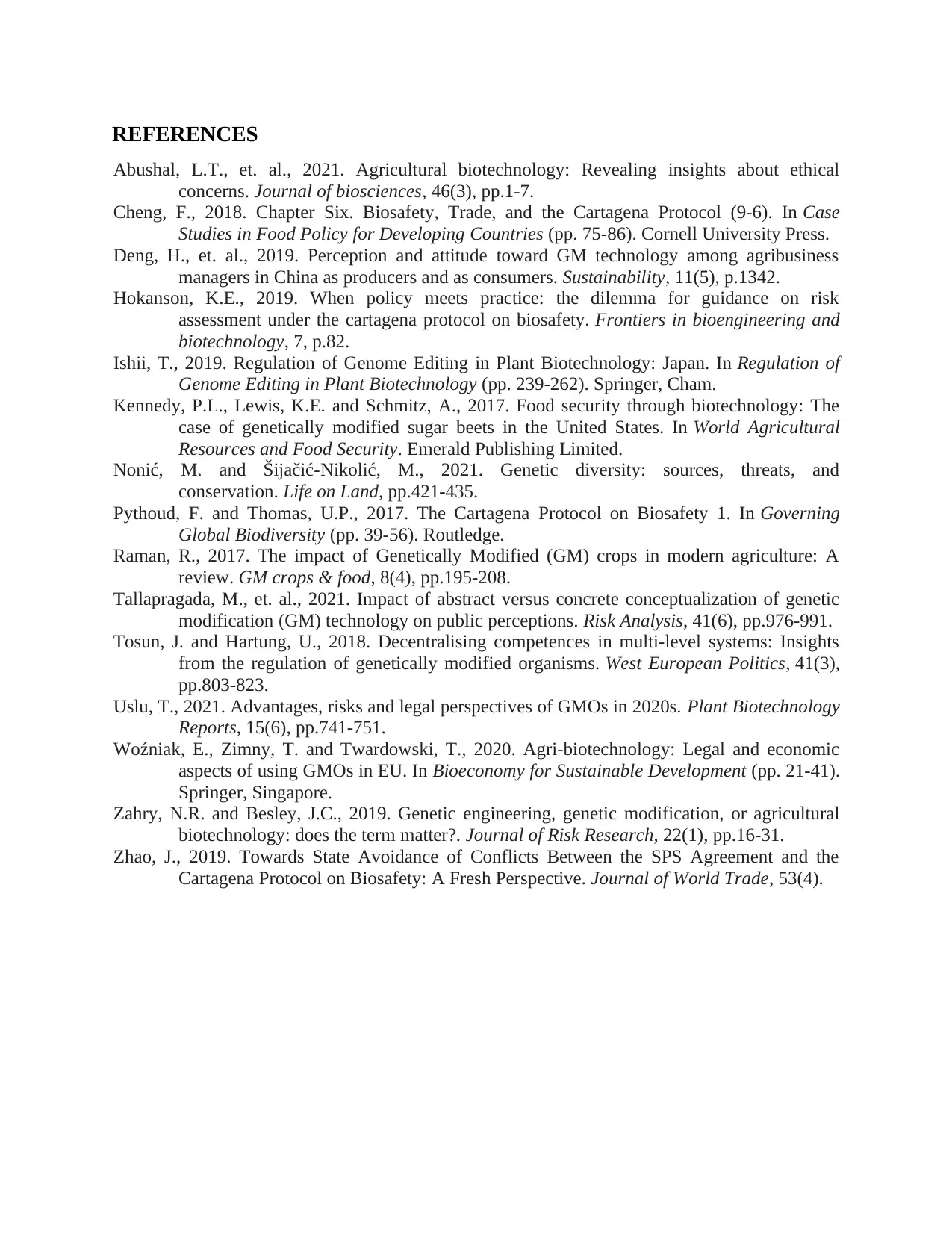
REFERENCES
Abushal, L.T., et. al., 2021. Agricultural biotechnology: Revealing insights about ethical
concerns. Journal of biosciences, 46(3), pp.1-7.
Cheng, F., 2018. Chapter Six. Biosafety, Trade, and the Cartagena Protocol (9-6). In Case
Studies in Food Policy for Developing Countries (pp. 75-86). Cornell University Press.
Deng, H., et. al., 2019. Perception and attitude toward GM technology among agribusiness
managers in China as producers and as consumers. Sustainability, 11(5), p.1342.
Hokanson, K.E., 2019. When policy meets practice: the dilemma for guidance on risk
assessment under the cartagena protocol on biosafety. Frontiers in bioengineering and
biotechnology, 7, p.82.
Ishii, T., 2019. Regulation of Genome Editing in Plant Biotechnology: Japan. In Regulation of
Genome Editing in Plant Biotechnology (pp. 239-262). Springer, Cham.
Kennedy, P.L., Lewis, K.E. and Schmitz, A., 2017. Food security through biotechnology: The
case of genetically modified sugar beets in the United States. In World Agricultural
Resources and Food Security. Emerald Publishing Limited.
Nonić, M. and Šijačić-Nikolić, M., 2021. Genetic diversity: sources, threats, and
conservation. Life on Land, pp.421-435.
Pythoud, F. and Thomas, U.P., 2017. The Cartagena Protocol on Biosafety 1. In Governing
Global Biodiversity (pp. 39-56). Routledge.
Raman, R., 2017. The impact of Genetically Modified (GM) crops in modern agriculture: A
review. GM crops & food, 8(4), pp.195-208.
Tallapragada, M., et. al., 2021. Impact of abstract versus concrete conceptualization of genetic
modification (GM) technology on public perceptions. Risk Analysis, 41(6), pp.976-991.
Tosun, J. and Hartung, U., 2018. Decentralising competences in multi-level systems: Insights
from the regulation of genetically modified organisms. West European Politics, 41(3),
pp.803-823.
Uslu, T., 2021. Advantages, risks and legal perspectives of GMOs in 2020s. Plant Biotechnology
Reports, 15(6), pp.741-751.
Woźniak, E., Zimny, T. and Twardowski, T., 2020. Agri-biotechnology: Legal and economic
aspects of using GMOs in EU. In Bioeconomy for Sustainable Development (pp. 21-41).
Springer, Singapore.
Zahry, N.R. and Besley, J.C., 2019. Genetic engineering, genetic modification, or agricultural
biotechnology: does the term matter?. Journal of Risk Research, 22(1), pp.16-31.
Zhao, J., 2019. Towards State Avoidance of Conflicts Between the SPS Agreement and the
Cartagena Protocol on Biosafety: A Fresh Perspective. Journal of World Trade, 53(4).
Abushal, L.T., et. al., 2021. Agricultural biotechnology: Revealing insights about ethical
concerns. Journal of biosciences, 46(3), pp.1-7.
Cheng, F., 2018. Chapter Six. Biosafety, Trade, and the Cartagena Protocol (9-6). In Case
Studies in Food Policy for Developing Countries (pp. 75-86). Cornell University Press.
Deng, H., et. al., 2019. Perception and attitude toward GM technology among agribusiness
managers in China as producers and as consumers. Sustainability, 11(5), p.1342.
Hokanson, K.E., 2019. When policy meets practice: the dilemma for guidance on risk
assessment under the cartagena protocol on biosafety. Frontiers in bioengineering and
biotechnology, 7, p.82.
Ishii, T., 2019. Regulation of Genome Editing in Plant Biotechnology: Japan. In Regulation of
Genome Editing in Plant Biotechnology (pp. 239-262). Springer, Cham.
Kennedy, P.L., Lewis, K.E. and Schmitz, A., 2017. Food security through biotechnology: The
case of genetically modified sugar beets in the United States. In World Agricultural
Resources and Food Security. Emerald Publishing Limited.
Nonić, M. and Šijačić-Nikolić, M., 2021. Genetic diversity: sources, threats, and
conservation. Life on Land, pp.421-435.
Pythoud, F. and Thomas, U.P., 2017. The Cartagena Protocol on Biosafety 1. In Governing
Global Biodiversity (pp. 39-56). Routledge.
Raman, R., 2017. The impact of Genetically Modified (GM) crops in modern agriculture: A
review. GM crops & food, 8(4), pp.195-208.
Tallapragada, M., et. al., 2021. Impact of abstract versus concrete conceptualization of genetic
modification (GM) technology on public perceptions. Risk Analysis, 41(6), pp.976-991.
Tosun, J. and Hartung, U., 2018. Decentralising competences in multi-level systems: Insights
from the regulation of genetically modified organisms. West European Politics, 41(3),
pp.803-823.
Uslu, T., 2021. Advantages, risks and legal perspectives of GMOs in 2020s. Plant Biotechnology
Reports, 15(6), pp.741-751.
Woźniak, E., Zimny, T. and Twardowski, T., 2020. Agri-biotechnology: Legal and economic
aspects of using GMOs in EU. In Bioeconomy for Sustainable Development (pp. 21-41).
Springer, Singapore.
Zahry, N.R. and Besley, J.C., 2019. Genetic engineering, genetic modification, or agricultural
biotechnology: does the term matter?. Journal of Risk Research, 22(1), pp.16-31.
Zhao, J., 2019. Towards State Avoidance of Conflicts Between the SPS Agreement and the
Cartagena Protocol on Biosafety: A Fresh Perspective. Journal of World Trade, 53(4).
1 out of 12
Related Documents
Your All-in-One AI-Powered Toolkit for Academic Success.
+13062052269
info@desklib.com
Available 24*7 on WhatsApp / Email
![[object Object]](/_next/static/media/star-bottom.7253800d.svg)
Unlock your academic potential
© 2024 | Zucol Services PVT LTD | All rights reserved.





